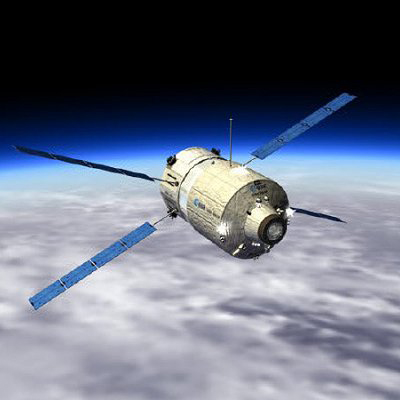European Spaceship Passes Rendezvous, Escape Tests

Europe's first automated "Jules Verne" cargo ship passed several crucial tests today above the Earth inpreparation for docking at the International Space Station (ISS) in less than a week.
The unmanned, double-decker bus-sizedspacecraft safely guided itself to a point just 2.2 miles (3.5 km) behindthe space station, closing a 21.8-mile (34.5-km) gap in the process. The shipthen successfully performed a test escape maneuver after receiving commandsfrom mission controllers on the ground.
"Allsystems were completely nominal, which is very satisfying for this first day ofreally testing the rendezvous capability of the spacecraft," said John Ellwood,the European Space Agency's (ESA) project manager for the Jules Verne program.
The 21-tonship, also known as an automatedtransport vehicle (ATV), is designed to ferry about three times the amountof fuel, oxygen, water and other supplies into space than Russia's Progress cargo ship can.
The ESAexpects this Jules Verne — the first of up to seven ships planned — to dock atthe space station on April 3.
Firstdemo day
In additionto sneaking up on the space station and showing off its escape maneuvers, the 21-tonJules Verne established a two-way data link with the ISS.
Get the Space.com Newsletter
Breaking space news, the latest updates on rocket launches, skywatching events and more!
The streamof GPS (global positioning satellite) information is expected help the ship navigateto the space station with extreme accuracy as well as allow two-way communication,should the ISS crew need to abort its docking maneuvers.
When JulesVerne reached its closest holding position behind the Russian-built Zvezdaservice module, the 1.3 billion euro ($1.9 billion) craft turned on its bright trackinglights and rendezvous radar equipment.
The Russian-builtKurs radar system, which has been used for decades on spacecraft, successfully delivereddistance and speed information to the space station's on-orbit crew.
Closingin
During thedemonstration, which is one of two planned before Thursday's anticipated docking, astronautson board the space station said they could see Jules Verne drifting behind them.
Groundcontrollers at the ship's Toulouse, France control center could also see thespacecraft on video screens.
"For theflight control team, the sight of the ATV thrusters firing was particularlyexciting and brought the whole thing to life," said Bob Chesson, head of theESA?s human spaceflight operations. "It was fantastic to be reunited with JulesVerne and to see it performing so perfectly, which is very promising for thedays to come."
Technicians are now analyzing the demonstration day data and will soon submittheir report to space station mission managers. If the assessment is normal,Jules Verne will be slated for a second day of demonstrations on March 31,which will bring the giant ship within 36 feet (11 m) of the space station.
"The firstanalysis from the [team is] looking pretty good," said Alberto Novelli,ESA?s mission director at ATV control center. "We are going to spend somehours now analysing them further. We are quite confident."
- VIDEO: Part 1: Europe's First ISS Cargo Ship
- VIDEO: Part 2: Jules Verne, Europe's First ISS Cargo Tug
- VIDEO: Columbus: Europe's Orbital Lab at ISS
Join our Space Forums to keep talking space on the latest missions, night sky and more! And if you have a news tip, correction or comment, let us know at: community@space.com.
Dave Mosher is currently a public relations executive at AST SpaceMobile, which aims to bring mobile broadband internet access to the half of humanity that currently lacks it. Before joining AST SpaceMobile, he was a senior correspondent at Insider and the online director at Popular Science. He has written for several news outlets in addition to Live Science and Space.com, including: Wired.com, National Geographic News, Scientific American, Simons Foundation and Discover Magazine.









